Home > Make It Count 2 > Findings > Professional Practice > 3. Plan > 3.7 Kinaesthetic > Significant episodes > Hands on activities I
Hands on activities I
Nicki Collocott
Gladstone Cluster
Finding 3.7: Kinaesthetic
Use kinaesthetic pedagogical practices as a point of entry to abstract mathematics knowledge.
Background
Through the professional development and collaborative sessions I was involved in, it became clear that our Indigenous students seemed to learn mathematical ideas better when a ‘hands-on’ approach was used. I decided to incorporate as many ‘hands-on’ activities as possible to help the students.
What happened?
There were many examples, but the following activities are two I used to help the students learn about circles.
1. We lookied at relationships between circumference and diameter and radius lines by:
- Cutting out a piece of wool of any size between 2 and 10 cm
- Using our piece of wool to draw a circle one end (by holding one end down on the centre of our page and the other end onto our pencil)
- To record the group’s measurements of the wool
- Estimating how many times our piece of wool would be needed to go around our circle and checking with our piece of wool
- Recording all our estimates and measurements in a table
- Analysing our table to see if there were any similarities
- Writing what we found in a mathematical way – we discovered that if we doubled every one’s piece of wool then multiply it by approx. 3, we could work out the circumference)
- Introducing pi and its value
- Checking pi could be part of the relationship and how
- Extending it by working backwards (knowing the circumference, their working out the diameter or radius).
2. We looked at area of a circle by:
- Using our same piece of wool to draw a circle on 1 cm graph paper estimating the number of square inside the circle
- Repeating the process of collecting data in a table
- Looking for relationships
- Coming up with a mathematical way of writing it
- Checking that it worked for everyone
- Extending this by working backwards (knowing the area, and then working out the radius).
I believe that the hands-on approach has seen Indigenous students (and other students) engage with mathematics in a more positive way…I think the increased engagement and improved attitude will eventually lead to improved results.
Some questions to prompt discussions with your colleagues:
- Can you think of other mathematical concepts that students might understand better when they see, feel and can play with a concrete example of the concept?
- How could their teacher make links to abstract or symbolic representations of the mathematics?
- What other interesting or important aspects are in this Significant Episode?
Learning through hands-on activities
Download the PDF of this significant episode.

